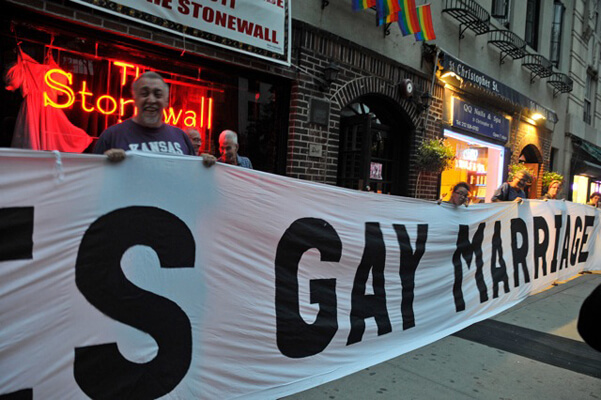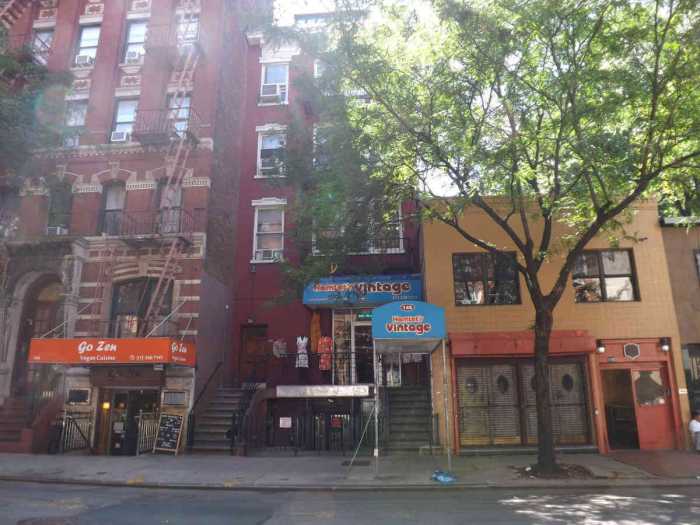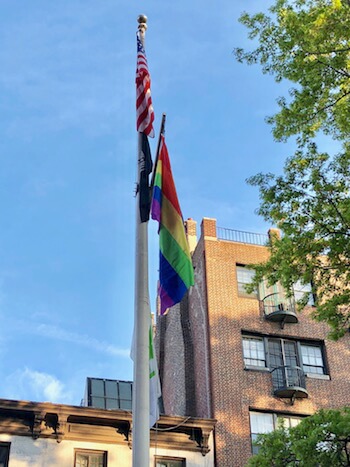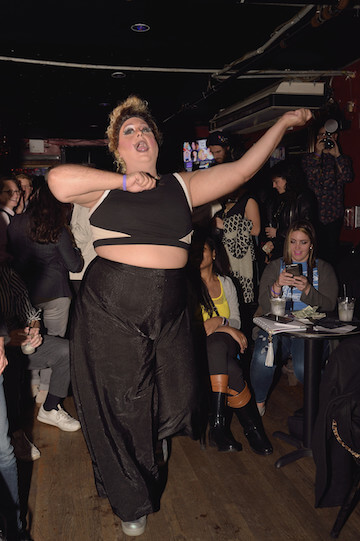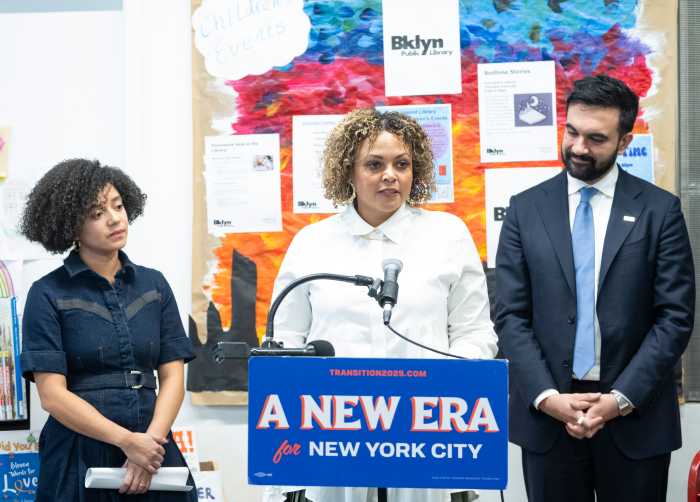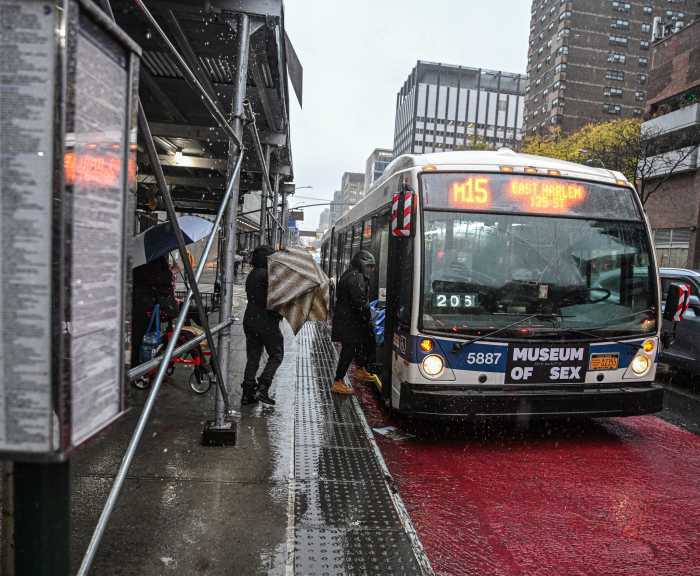Jubilant crowds gathered outside the Stonewall Inn on June 24, 2011 to celebrate the enactment of marriage equality in New York State that evening in Albany. | DONNA ACETO
The Stonewall Inn bar –– the 1969 raid on which sparked the modern LGBT liberation movement –– is on a street renamed Stonewall Place and was made an official National Historic Landmark in 2000, but it does not have an official plaque marking its role in history.
Gay State Senator Brad Hoylman has been trying to rectify that. After an ill-fated collaboration with the Historic Landmarks Preservation Center –– a private group that establishes plaques around the city but would not invite folks who actually engaged in the Stonewall Rebellion to participate in a July ceremony that in the end was canceled –– Hoylman teamed up with Assemblywoman Deborah Glick and City Council Speaker Christine Quinn, LGBT colleagues who also represent the area around the famed bar, to develop a plaque through an open community process.
The first step in that process, an October 15 meeting of Community Board 2’s Landmarks & Public Aesthetics Committee, was brief, with the committee quickly deciding that disagreements that have already surfaced about the language of such a plaque and related questions make it appropriate for CB2’s Social Services & Education Committee to hold the first public hearings. That committee next meets in November, though the Stonewall plaque issue is not yet on its calendar.
Landmarks Preservation Committee steps into void after collapse of private effort, but wide diversity of views on the hows and wheres
Explaining the importance of his effort, Hoylman said, “Many people said that the building should have some sort of recognition on the façade. In the future, it might be a boutique or something,” rather than a gay bar. Indeed, for a long time after it ceased being a bar in the 1970s, it was a bagel place.
Community Board 2, Hoylman explained, is the logical sponsor of the plaque since the city itself cannot do so “because it is already in a landmarked district.” The city’s Landmark Preservation Commission, however, did put forward the draft text for the plaque, which is based on an earlier version written by historian Martin Duberman. Although Duberman is one of the nation’s foremost scholars on LGBT history and the author of a 1993 book on the Rebellion, the text developed from his original language is drawing criticism from other veteran LGBT activists.
The language that will go before CB 2 reads:
Stonewall Inn
53 Christopher Street
Here on the early morning of June 28, 1969, the police raided the Stonewall Inn, a gay bar. What followed were six days of sporadic riots by hundreds of members of the lesbian, gay, bisexual and transgender community, demanding an end to police harassment, arrests and raids on gay establishments. The Stonewall Rebellion is widely regarded as the catalyst for the modern LGBT liberation movement and was noted by President Barack Obama in his 2013 inaugural address, the first time a president referred to gay rights in such a speech.
Greenwich Village Historic District: 1969
National Register of Historic Places: 1999
New York State Register of Historic Places: 1999
National Historic Landmark: 2000
During the kerfuffle over the proposed private plaque back in July, Stonewall veteran Jerry Hoose raised a central critique of the entire enterprise, asking why a mob-run establishment that often exploited LGBT patrons should be honored. “I’m so tired of that bar being glorified,” he said. “It was this horrendous place where something great happened.”
Stonewall veteran Jim Fouratt, in an email message, echoed Hoose’s thinking. “I would have objected to the choosing of an organized crime run bar that I have always seen as a symbol of lesbian and gay oppression, not liberation,” he wrote. “It was a seedy, dirty, unlicensed, cop pay-off joint that served expensive, water down drinks and had thugs at the door… What needs to be celebrated and commemorated is outside the bar in the street where a very diverse representation of who we are in all our gender, racial and economic diversity found the courage to rebel against oppression and to come out and be visible.”
Fouratt also objected to citing Obama on the plaque, writing, “Oh please, he said nothing the first four years in office and had a history of stating publicly he was opposed to same-sex civil marriage. Only when it was clear that the Supreme Court was going to rule in favor of equal treatment under the law and he needed the LGBT vote did he finally come out and say our collective name.”
Fouratt suggested “that a plaque also be placed at the bottom of Christopher Street where generations of young LGBT youth, now mostly of color and transgender expression, have gathered to celebrate their diversity and sense of freedom. Today these mostly young people are being harassed by police and neighborhood ‘vigilante’ groups under the mask of block associations and business alliances.”
Andrew Berman, who is gay and the head of the Greenwich Village Society for Historic Preservation (GVSHP), had a more complicated critique of the project. “We are taking a close look at this,” he wrote in an email. “Ever since GVSHP and allies got the Stonewall listed on the State and National Registers of Historic Places in 1999 –– the first site ever so recognized for its connection to LGBT history –– we have been trying to call attention to a number of sites whose LGBT history is in danger of being forgotten or destroyed.
“One of the few ways to protect our LGBT history sites is through New York City landmark designation, and the city has thus far been quite resistant to doing so. While the Stonewall is technically within the Greenwich Village Historic District, as noted in the draft plaque language, the district was designated in April of 1969, and thus the designation report –– the governing document for that landmark designation –– makes no mention of the Stonewall riots. The Landmark Preservation Commission has never amended this or taken any formal steps to recognize or protect the LGBT history of the Stonewall, much as they refused to landmark 186 Spring Street, a house connected to some of the leading figures of the post-Stonewall LGBT rights movement, which as a result was demolished last year. Thus the level of protection or recognition that the Stonewall’s inclusion in the Greenwich Village Historic District offers is questionable.
“Therefore including reference to Stonewall’s ‘inclusion’ in the Greenwich Village Historic District in the plaque might be misleading and add to a false sense of security about the level of protection and recognition that our historic sites have, and downplay the work we still must do.”
Veteran activist Bill Dobbs, too young to have been at Stonewall, also had a critique of the proposed text, writing that it should instead begin, “Here on the early morning of June 28, 1969 the NYPD Public Morals Squad raided the Stonewall Inn, a gay bar, and met resistance from patrons being arrested and others nearby.”
Dobbs, too, would delete the reference to Obama and said the plaque should note that in the wake of Stonewall, “new groups quickly took up the cause in New York and across the country.”
Given the controversy that the language and location of any plaque commemorating the Stonewall Rebellion has already engendered, it’s not surprising that CB2’s Landmarks Committee made a quick call on October 15 that Social Services, which includes under its charge LGBT issues, was the place to get the public discussion started. Assuming consensus is achieved there on the appropriate wording and placement of a plaque, the issue would likely return to Landmarks for resolution of issues related to its design and crafting.
Hoylman said there is no set timeline for getting this plaque in place. But he emphasized that what it says and where it goes will depend a lot on the direction members of the LGBT and West Village communities offer. His office encourages community members wishing to participate in the open process but unable to attend specific meetings to send their input to info@cb2manhattan.org.

